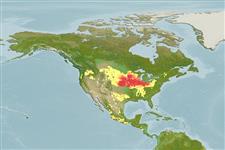Classification / Names
Common names | Synonyms | Catalog of Fishes (gen., sp.) | ITIS | CoL | WoRMS | Cloffa
Actinopterygii (ray-finned fishes) >
Cypriniformes (Carps) >
Cyprinidae (Minnows or carps) > Leuciscinae
Etymology: Phenacobius: Greek, phenax, -akos = deceptive + Greek, bios = life (Ref. 45335); mirabilis: From the word mirabilis, meaning wonderful (Ref. 10294).
Environment / Climate / Range
Ecology
Freshwater; demersal; pH range: 6.5 - 7.8; dH range: 5 - 25. Subtropical; 5°C - 25°C (Ref. 13614), preferred ?; 45°N - 30°N
North America: Mississippi River basin; western Lake Erie drainage in Ohio and Michigan USA; isolated populations in Gulf drainages (Sabine River in Louisiana and Texas; Trinity and Colorado River in Texas; Pecos River in New Mexico).
Size / Weight / Age
Maturity: Lm ? range ? - ? cm
Max length : 12.0 cm TL male/unsexed; (Ref. 86798); common length : 4.6 cm TL male/unsexed; (Ref. 12193); max. reported age: 3 years (Ref. 12193)
Phenacobius mirabilis is distinguished by having the following characters: bicolored body, olive-brown above, silver white below; large fleshy lips; caudal fin base with intense black spot following thin dark stripe along side of body; 42-51 scales on lateral line; 15-17 scales around caudal peduncle; thin dark stripe along black; darkly outlined scales on black and upper side (Ref. 86798)
Inhabits gravel and rubble riffles and runs of clear to turbid creeks and small to medium, sometimes large rivers (Ref. 5723, 10294). Feeds on insect larvae (Ref. 79012).
Life cycle and mating behavior
Maturity | Reproduction | Spawning | Eggs | Fecundity | Larvae
Page, L.M. and B.M. Burr, 2011. A field guide to freshwater fishes of North America north of Mexico. Boston : Houghton Mifflin Harcourt, 663p. (Ref. 86798)
IUCN Red List Status (Ref. 115185)
CITES (Ref. 94142)
Not Evaluated
Threat to humans
Harmless
Human uses
More information
ReferencesAquacultureAquaculture profileStrainsGeneticsAllele frequenciesHeritabilityDiseasesProcessingMass conversion
Tools
Special reports
Download XML
Internet sources
